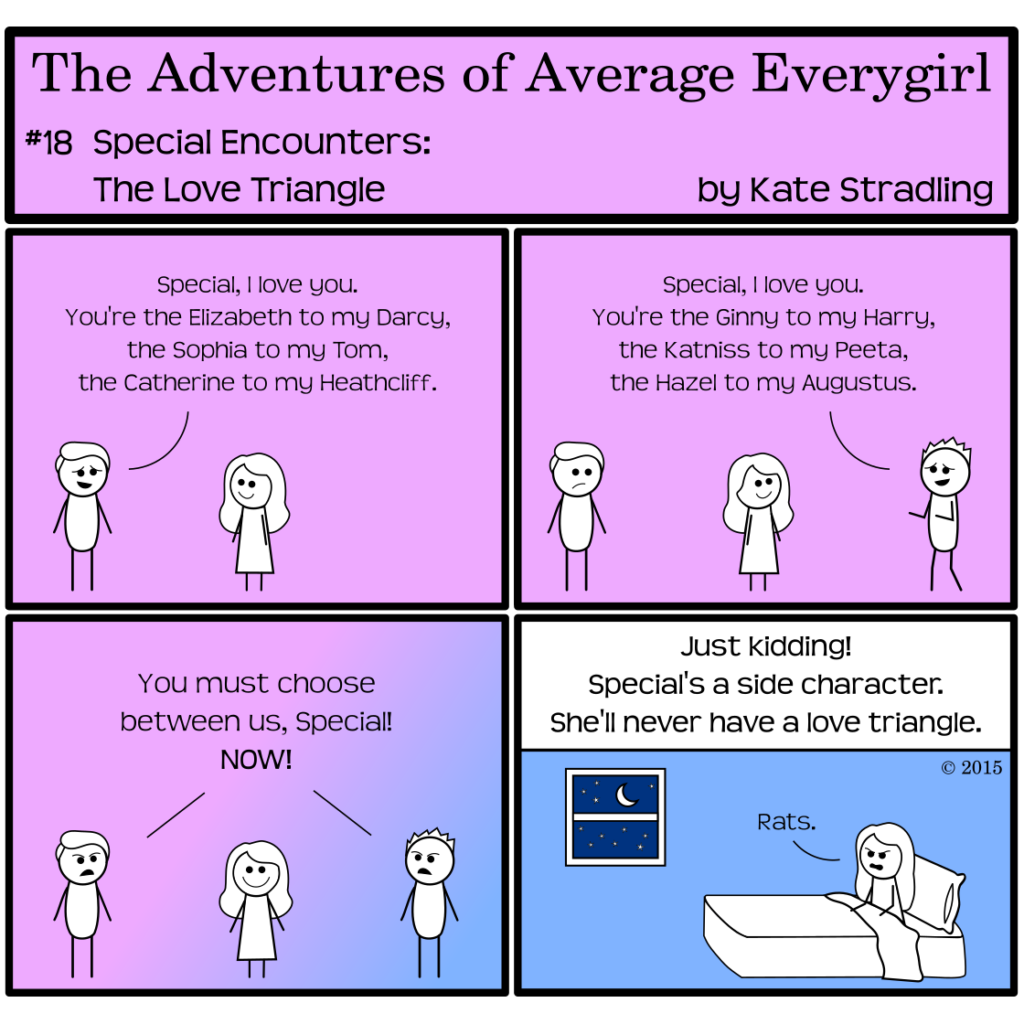
Poor Special. Quirky side characters only find love with other quirky side characters. A triangle is out of the question.
(Unless it’s really quirky, I mean.)
Side characters fulfilling their purpose
Often when MarySue appears in a story, another phenomenon occurs: side characters that exist only to validate or compliment her existence. Their motivations are flat, their desires are unimportant, and if they have a relationship, it’s quite possibly for comic purposes alone. These side characters give MarySue someone to talk to, someone to make her look good, someone to highlight how awesome she is without ever stealing the limelight.
They are, in essence, cardboard cutouts. Decorations. Props.
They parrot dialogue that allows MarySue to show her wit. They make rash decisions that allow her to demonstrate wisdom. MarySue is the center of the universe. Everything else must point to her and her amazincredifabulosity.
And it’s a colossal waste.
Side characters can have their own hopes, dreams, motivations, impulses, personalities, etc. without ruining a story. I would posit that they need all of these for a story to really, truly shine. The world is made up of individuals, all possessing a unique perspective on life. We’re all the main character in our own story. Literary worlds should reflect that diversity of thought.
Some authors who do this particularly well:
- Diana Wynne Jones: While I love Howl’s Moving Castle, I think House of Many Ways might be my favorite of her books. The main characters from Howl’s appear as side characters in House, to hysterical ends. (I’m sorry. There is no keeping a straight face during Twinkle’s scenes. It’s just not possible, unless you have no soul.) Even so, they don’t outshine House‘s Charmain in the least. Rather, they all work together nicely to create a sense of a broad and varied world where many interesting people live.
- Elizabeth Peters: Some authors create a new, alternate world for every book they write. Peters’s characters apparently all live together in one grand universe. The Vicky Bliss series in particular ties together multiple literary threads: Sir John Smythe has his first jaunt in a non-series book (as the villain, no less), the crime syndicate from Books #3 and 5 operates beyond the scope of the series, and even Amelia Peabody, from a completely different series and era, gets a nod.
- Agatha Christie: Keep an eye on her side characters. They’re doubtless up to something. Bundle Brent, a side from The Secret of Chimneys, gets her romp as the main in The Seven Dials Mystery; Superintendent Battle from both of those shows up in the Poirot mystery, Cards on the Table. And even though Poirot and Miss Marple never cross paths, they do exist in the same universe.
Rounding out the flatness
I’m not saying that characters from one book must appear in another. I’m also not advocating an over-development of side characters to create an entire cast of MarySues. For me, a good side character is one with enough substance to have his or her own story as a main character, even if that story is never written. What makes characters real is not just reading about them in the small frame of the story, but knowing that there is more to their life than is contained within that story’s scope—and not because external events even receive mention, but because the characters behave in such a way that I can imagine them in situations beyond what the author gives me.
It’s one of the reasons I dislike the term “window character.” While yes, side characters are great for allowing the reader to witness a main character’s true self, they can do this while still having their own personalities, while being more than a transparent pane of glass. They have to exist beyond their interactions with the main character. Otherwise they’re just little yes-men.
And if that’s the case, they might as well be made from cardboard. Really.
Poor Special. I love her face in the third panel. She’s so happy! Then BAM! Reality.
Yeah. She’s pretty peeved about it at the end. 😀
And that is why one should never name a child “Special”. It just sets one up for obscurity.
Thanks for the nod to the family favorite, Elizabeth Peters. Should every other topic fail to bring us together, we’ll always have chocolate cake and E.P.
She’s special to someone, I’m sure.
Chocolate cake and E.P. sounds like a perfect evening in. Yes, please!
Comments are closed.